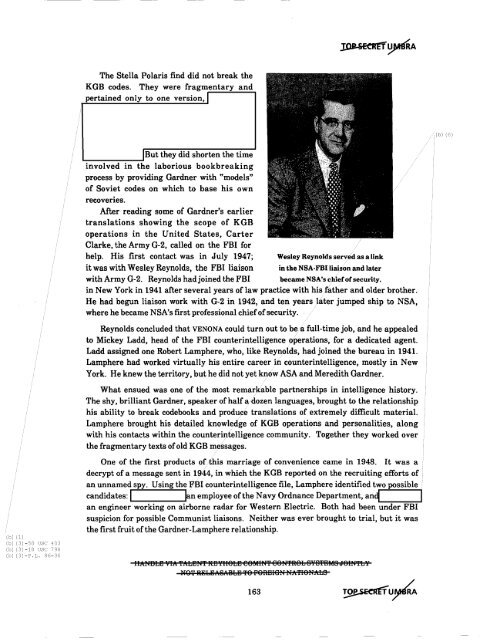American Cryptology during the Cold War - The Black Vault
American Cryptology during the Cold War - The Black Vault
American Cryptology during the Cold War - The Black Vault
Create successful ePaper yourself
Turn your PDF publications into a flip-book with our unique Google optimized e-Paper software.
<strong>The</strong> Stella Polaris find did not break <strong>the</strong><br />
KGB codes. <strong>The</strong>y were fragmentary and<br />
pertained only to one version,<br />
Ib) (6)<br />
(1)<br />
Ib) (3) -50 USC 403<br />
Ib) (3) -18 USC 798<br />
Ib) (3) -P.L. 86-36<br />
'-- ----1But <strong>the</strong>y did shorten <strong>the</strong> time<br />
involved in <strong>the</strong> laborious bookbreaking<br />
process by providing Gardner with "models"<br />
of Soviet codes on which to base his own<br />
recoveries.<br />
After reading some of Gardner's earlier<br />
translations showing <strong>the</strong> scope of KGB<br />
operations in <strong>the</strong> United States, Carter<br />
Clarke, <strong>the</strong> Army G-2, called on <strong>the</strong> FBI for<br />
help. His first contact was in July 1947; Wesley Reynolds served as a link<br />
it was with Wesley Reynolds, <strong>the</strong> FBI liaison in <strong>the</strong> NSA·FBI liaison and later<br />
with Army G-2. Reynolds hadjoined <strong>the</strong> FBI became NSA's chiefofsecurity.<br />
in New York in 1941 after several years of law practice with hisfa<strong>the</strong>r and older bro<strong>the</strong>r.<br />
He had begun liaison work with G-2 in 1942, and ten years later jumped ship to NSA,<br />
where he became NSA's first professional chiefofsecurity.<br />
Reynolds concluded that VENONA could turn out to be. a full-time job, and he appealed<br />
to Mickey Ladd, head of <strong>the</strong> FBI counterintelligence operations, for a dedicated agent.<br />
Ladd assigned one Robert Lamphere, who, like Reynolds, had joined <strong>the</strong> bureau in 1941.<br />
Lamphere had worked virtually his entire career in counterintelligence, mostly in New<br />
York. He knew <strong>the</strong> territory, but he did not yet know ASA and Meredith Gardner.<br />
What ensued was one of <strong>the</strong> most remarkable partnerships in intelligence history.<br />
<strong>The</strong> shy, brilliant Gardner, speaker of halfa/dozen languages, brought to <strong>the</strong> relationship<br />
his ability to break codebooks and produce translations of extremely difficult material.<br />
Lamphere brought his detailed knowledge of KGB operations and personalities, along<br />
with his contacts within <strong>the</strong> counterintelligence community. Toge<strong>the</strong>r <strong>the</strong>y worked over<br />
<strong>the</strong> fragmentary texts ofold KGB messages.<br />
One of <strong>the</strong> first products of/this marriage of convenience came in 1948. It was a<br />
decrypt of a message sent in 1944, in which <strong>the</strong> KGB reported on <strong>the</strong> recruiting efforts of<br />
an unnamed spy. Using <strong>the</strong> FBI counterintelligence file, Lamphere identified two possible<br />
candidates:I ~n employee of<strong>the</strong> Navy Ordnance Department, an~ I<br />
an engineer working on airborne radar for Western Electric. Both had been under FBI<br />
suspicion for possible Communist liaisons. Nei<strong>the</strong>r was ever brought to trial, but it was<br />
<strong>the</strong> first fruit of<strong>the</strong> Gardner-Lamphere relationship.<br />
IIftUBI:il!J VIA 'fAI:il!JU'f IEl!JYIISLl!J eaMHi'f eSN'fRab SY&FBMS
















